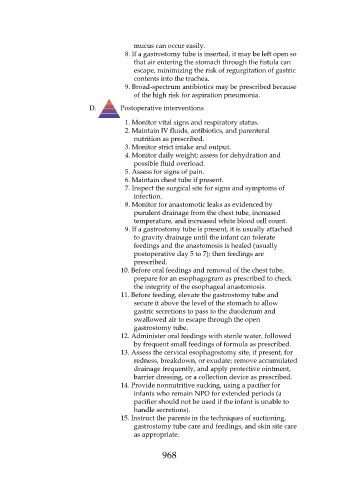Page 968 - Saunders Comprehensive Review For NCLEX-RN
P. 968
mucus can occur easily.
8. If a gastrostomy tube is inserted, it may be left open so
that air entering the stomach through the fistula can
escape, minimizing the risk of regurgitation of gastric
contents into the trachea.
9. Broad-spectrum antibiotics may be prescribed because
of the high risk for aspiration pneumonia.
D. Postoperative interventions
1. Monitor vital signs and respiratory status.
2. Maintain IV fluids, antibiotics, and parenteral
nutrition as prescribed.
3. Monitor strict intake and output.
4. Monitor daily weight; assess for dehydration and
possible fluid overload.
5. Assess for signs of pain.
6. Maintain chest tube if present.
7. Inspect the surgical site for signs and symptoms of
infection.
8. Monitor for anastomotic leaks as evidenced by
purulent drainage from the chest tube, increased
temperature, and increased white blood cell count.
9. If a gastrostomy tube is present, it is usually attached
to gravity drainage until the infant can tolerate
feedings and the anastomosis is healed (usually
postoperative day 5 to 7); then feedings are
prescribed.
10. Before oral feedings and removal of the chest tube,
prepare for an esophagogram as prescribed to check
the integrity of the esophageal anastomosis.
11. Before feeding, elevate the gastrostomy tube and
secure it above the level of the stomach to allow
gastric secretions to pass to the duodenum and
swallowed air to escape through the open
gastrostomy tube.
12. Administer oral feedings with sterile water, followed
by frequent small feedings of formula as prescribed.
13. Assess the cervical esophagostomy site, if present, for
redness, breakdown, or exudate; remove accumulated
drainage frequently, and apply protective ointment,
barrier dressing, or a collection device as prescribed.
14. Provide nonnutritive sucking, using a pacifier for
infants who remain NPO for extended periods (a
pacifier should not be used if the infant is unable to
handle secretions).
15. Instruct the parents in the techniques of suctioning,
gastrostomy tube care and feedings, and skin site care
as appropriate.
968

